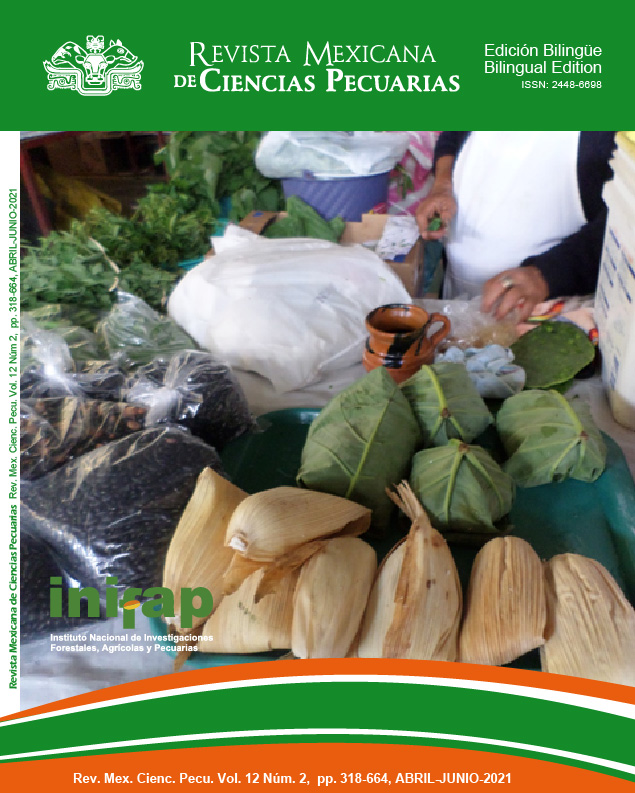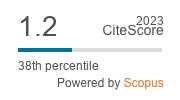Eficacia del timol en el control del hongo Nosema ceranae infectando abejas africanizadas
DOI:
https://doi.org/10.22319/rmcp.v12i2.5480Palabras clave:
Nosema ceranae, Nosemosis, Fumagilina, Timol, Eficacia, Apis melliferaResumen
Nosema ceranae, es un parásito obligatorio del intestino medio de las abejas melíferas que causa destrucción de las células epiteliales afectando la digestión y asimilación del alimento, impactando negativamente el desarrollo y sobrevivencia de las colonias de abejas. Con la finalidad de reducir los efectos negativos, se evaluó la eficacia del timol en el control de esta parasitosis. El estudio se realizó en dos apiarios experimentales con un total de 56 colonias de abejas distribuidas en tres grupos experimentales: G1) 18 colonias que recibieron tratamiento con fumagilina como producto de referencia (25.2 mg de fumagilina/semana); G2) 19 colonias que recibieron tratamiento con timol como producto alternativo (66 mg de cristales/semana) y G3) 19 colonias que no recibieron ningún tratamiento (grupo testigo). Los tratamientos con la fumagilina y timol se aplicaron a través del jarabe de azúcar una vez por semana durante cuatro semanas consecutivas. Los niveles de infección de N. ceranae se estimaron en el macerado del abdomen de 60 abejas adultas colectadas de cada colonia experimental. Los resultados al final de los tratamientos indican que las colonias que recibieron fumagilina (G1) disminuyeron sus niveles de infección de 123,529 a 1,805 esporas por abeja; para G2 (timol), la reducción fue de 133,438 a 28,099 esporas por abeja, y para las colonias del grupo testigo (G3) fue de 119,306 a 36,447 esporas por abeja. Los tres grupos experimentales presentaron diferencias estadísticas significativas en los niveles de infección de N. ceranae al final de los tratamientos. La fumagilina presentó una mayor eficacia (95.2 %) en comparación con el timol la, cual fue baja (31.1 % de eficacia) indicando que se requieren estudios adicionales para determinar la concentración más efectiva a nivel de colonia bajo condiciones tropicales de Yucatán, a fin de que este aceite esencial de origen vegetal sea incorporado como producto alternativo para el control de esta parasitosis.
Descargas
Citas
Higes M, Martin R, Meana A. Nosema ceranae, a new microsporidian parasite in honeybees in Europe. J Inv Pathol 2006;(92):81-83.
Higes M, Martín R, Sanz A, Álvarez N, Sanz A, García MP, Meana A. El síndrome de despoblamiento de las colmenas en España. Consideraciones sobre su origen. Vida Apícola 2005;(133):15-21.
Higes M, Garcia‐Palencia P, Martin‐Hernandez R, Meana A. Experimental infection of Apis mellifera honeybees with Nosema ceranae (Microsporidia). J Invertebr Pathol 2007;(94):211–217.
Mayack C, Naug D. Energetic stress in the honeybee Apis mellifera from Nosema ceranae infection. J Inv Pathol 2009;(100):185–188.
Paxton RJ, Klee J, Korpela S, Fries I. Nosema ceranae has infected Apis mellifera in Europe since at least 1998 and may be more virulent than Nosema apis. Apidologie 2007;(38):558–565.
Goblirsch M, Huang ZY, Spivak M. Physiological and behavioral changes in honey bees (Apis mellifera) induced by Nosema ceranae infection. PLos One 2013;8(3):e58165.
Kralj J, Fuchs S. Nosema sp. influences flight behavior of infected honey bee (Apis mellifera) foragers. Apidologie 2010;(41):21–28.
Wolf S, McMahon DP, Lim KS, Pull CD, Clark SJ, Paxton RJ, Osborne JL. So near and yet so far: harmonic radar reveals reduced homing ability of Nosema infected honeybees. PLoS One 2014;9(8):e103989.
Fries I, Ekbohm G, Villumstad E. Nosema apis, sampling techniques and honey yield. J Apic Res 1984;(23):102–105.
Botías C, Martin-Hernandez R, Barrios L, Meana A, Higes M. Nosema spp. infection and its negative effects on honey bees (Apis mellifera iberiensis) at the colony level. Vet Res 2013;(44):25.
Higes M, Martín-Hernandez R, Botias C, Bailon EG, Gonzales-Porto A, Barrios L, del Nozal MJ, Palencia PG, Meana A. How natural infection by Nosema ceranae causes honeybee colony collapse. Environ Microbiol 2008;10(10):2659-2669.
Higes M, Martin-Hernandez R, Garrido-Bailon E, Gonzalez-Porto AV, Garcia-Palencia P, Meana A, et al. Honeybee colony collapse due to Nosema ceranae in professional apiaries. Environ Microbiol Rep 2009;1(2):110–113.
Klee J, Besana AM, Genersch E, Gisder S, Nanetti A, Tam DO, et al. Widespread dispersal of the microsporidian Nosema ceranae, an emergent pathogen of the western honeybee, Apis mellifera. J Invertebr Pathol 2007;96(1):1-10.
Goulson D, Nicholls E, Botías C, Rotheray EL. Bee declines driven by combined stress from parasites, pesticides, and lack of flowers. Science 2015;347(6229):1255957.
vanEngelsdorp D, Evans JD, Saegerman C, Mullin C, Haubruge E, Nguyen BK, et al. Colony collapse disorder: A descriptive study. PLoS One 2009;4(8):e6481.
Martínez J, Leal G, Conget P. Nosema ceranae an emergent pathogen of Apis mellifera in Chile. Parasitol Res 2012;(111):601–607.
Fries I. Nosema apis – a parasite in the honey bee colony. Bee World 1993;(74): 5-19.
Webster TC, Pomper KW, Hunt G, Thacker EM. Nosema apis infection in worker and queen Apis mellifera. Apidologie 2004;(35):49-54.
Martinez-Puc JFM, Medina, LAM, Catzin-Ventura GA. Frecuencia de Varroa destructor, Nosema apis y Acarapis woodi en colonias manejadas y enjambres silvestres de abejas (Apis mellifera) en Mérida, Yucatán, México. Rev Mex Cienc Pecu 2011;2(1):25-38.
García-Millán M, Quezada-Euan JJG. Distribución de Nosemiasis en apiarios comerciales del estado de Yucatán. Apicultura Moderna 1993;(5): 22-24.
Briceño-Uc AR. Estudio retrospectivo de microsporidos (Nosema apis y Nosema ceranae) en colmenas de Apis mellifera de Yucatán, México. [tesis maestría]. Mérida, Yucatán. Universidad Autónoma de Yucatán. 2013.
Fleites-Ayil FA, Quezada-Euan JJG, Medina ML. Onset of foraging and lifespan of Africanized honey bees (Apis mellifera) infected with different levels of Nosema ceranae spores in Neotropical Mexico. Apidologie 2018;(49):781–788.
Katznelson H, Jamieson CA. Control of Nosema disease of honey bees with fumagillin. Science 1952;(115):70-71.
Hartwig A, Przelecka A. Nucleic acids in the intestine of Apis mellifera infected with Nosema apis and treated with Fumagillin DCH: cytochemical and autoradiographic studies. J Invertebr Pathol 1971;18(3):331–336.
Liu TP. Ultrastructural changes in the secretion granules of the hypopharyngeal glands of the honeybee infected by Nosema apis and after treatment with fumagillin. Tissue Cell 1990;22(4):523-531.
Fries I. Nosema ceranae in European honey bees (Apis mellifera). J Invertebr Pathol 2010;(103):S73-S79.
van den Heever JP, Thompson TS, Curtis JM, Ibrahim A, Pernal SF. Fumagillin: an overview of recent scientific advances and their significance for apiculture. J Agric Food Chem 2014;(62):2728–2737.
Yücel B, Doğaroğlu M. The impact of Nosema apis Z. infestation of honey bee (Apis mellifera L.) colonies after using different treatment methods and their effects on the population levels of workers and honey production on consecutive years. Pakistan J Biol Sci 2005;8(8):1142-1145.
Maistrello L, Lodesani M, Costa C, Leonardi F, Marani G, Caldon M, Mutinelli F, Granato A. Screening of natural compounds for the control of nosema disease in honeybees (Apis mellifera). Apidologie 2008;(39):436-445.
Bogdanov S, Imdorf A, Kilchenmann V. Thymol residues in wax and honey after Apilife VAR Treatment. Swiss Bee Research Centre 1998;(133):1-9.
Orellana LR, Espadas MC, Nava MF. Climas. In: Durán R, Méndez M. editores. Biodiversidad y desarrollo humano en Yucatán. Yucatán, México: CONABIO-SEDUMA; 2010:10-11.
Chen Y, Evans J, Smith B, Pettis J. Nosema ceranae is a long-present and wide-spread microsporidian infection of the European honey bee (Apis mellifera) in the United States. J Invertebr Pathol 2007;(97):186-188.
Cantwell GE. Standard methods for counting Nosema spores. Am Bee J 1970;110(6):222-223.
Krebs CJ. Ecological Methodology. 2nd ed. Menlo Park, California, USA: Addison-Welsey Educational Publishers; 1999.
Hammer Ø, Harper DAT, Ryan PD. PAST: Paleontological statistics software package for education and data analysis. Palaeontologia Electronica 2001;4(1):9pp. http://palaeo-electronica.org/2001_1/past/issue1_01.htm. Consultado 12 May, 2018.
Traver BE, Williams MR, Fell RD. Comparison of within hive sampling and seasonal activity of Nosema ceranae in honey bee colonies. J Invertebr Pathol. 2012;(109):187-193.
Higes M, Nozal MJ, Álvaro A, Barrios L, Meana A, Martín-Hernández R, Bernal JL, Bernal J. The stability and effectiveness of fumagillin in controlling Nosema ceranae (Microsporidia) infection in honey bees (Apis mellifera) under laboratory and field conditions. Apidologie 2011;(42):364-377.
Williams GR, Sampson MA, Shutler D, Rogers REL. Does fumagillin control the recently detected invasive parasite Nosema ceranae in western honey bees (Apis mellifera)? J Invertebr Pathol 2008;(99):342–344.
Holt HL, Grozinger CM. Approaches and challenges to managing Nosema (Microspora: Nosematidae) parasites in honey bee (Hymenoptera: Apidae) colonies. J Econ Entomol 2016;(109):1487–1503.
Burnham AJ. Scientific advances in controlling Nosema ceranae (Microsporidia) infections in honey bees (Apis mellifera). Front Vet Sci 2019;(6):79.
van den Heever JP, Thompson TS, Otto SJG, Curtis, JM, Ibrahim A, Pernal SF. Evaluation of Fumagilin-B® and other potential alternative chemotherapies against Nosema ceranae-infected honeybees (Apis mellifera) in cage trial assays. Apidologie 2016;(47):617–630.
Descargas
Publicado
Cómo citar
-
Resumen1712
-
PDF645
-
PDF 396
Número
Sección
Licencia
Los autores/as que publiquen en la Revista Mexicana de Ciencias Pecuarias aceptan las siguientes condiciones:
De acuerdo con la legislación de derechos de autor, la Revista Mexicana de Ciencias Pecuarias reconoce y respeta el derecho moral de los autores/as, así como la titularidad del derecho patrimonial, el cual será cedido a la revista para su difusión en acceso abierto.

Esta obra está bajo una Licencia Creative Commons Atribución-NoComercial-CompartirIgual 4.0 Internacional.





